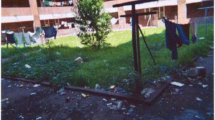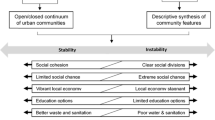Abstract
In this paper we discuss our conceptualisation of a ‘health-enabling social environment’, and some of the strategies we are currently using to build social contexts most likely to support effective HIV/AIDS management in southern Africa. In developing these ideas, we draw on our on-going collaboration with residents of Entabeni, a remote rural community in South Africa where 43% of pregnant women are HIV positive. The aim of this collaboration is to facilitate contextual changes that will enable more effective community-led HIV/AIDS management in an isolated area where people have little or no access to formal health or welfare support, and where HIV/AIDS is heavily stigmatised. We give an account of the three phases of collaboration to date. These include research; the dissemination of findings and community consultation about the way forward; preliminary project activities (skills training for volunteer health workers; partnership building and a youth rally) as a way of illustrating what we believe are six key strategies for facilitating the development of ‘AIDS-competent’ communities: building knowledge and basic skills; creating social spaces for dialogue and critical thinking; promoting a sense of local ownership of the problem and incentives for action; emphasising community strengths and resources; mobilising existing formal and informal local networks; and building partnerships between marginalized communities and more powerful outside actors and agencies, locally, nationally and internationally. We discuss some of the triumphs and trials of this work, concluding with a discussion of the need to set realistic goals when working at the community level in highly conservative patriarchal communities to tackle problems which may be shaped by economic and political processes over which local people have little control.
Similar content being viewed by others
Notes
A community is usually defined either as a group of people who share a common social identity, or as a group who live in a common geographical space. In practice—for reasons relating to place-based resource allocation and convenience—health interventions usually target their efforts at geographically defined communities. This is particularly the case in geographically remote areas such as the one discussed in this paper. As a result, we use this place-based notion of community in our work.
HIVAN is a university-based NGO, devoted to developing research and practice in the field of HIV/AIDS networking. http://www.hivan.org.za/gettoknowus/team.asp#dI
Entabeni is a pseudonym for our community of interest.
We use the term ‘social capital’ with some caution, given the critique that Putnam’s (2000) popular definition of this term directs attention too narrowly to the community level of analysis, ignoring the impact of wider political and economic determinants of social problems. In our work we use Bourdieu’s conceptualisation of this term, because of Bourdieu’s (1986) sensitivity to the way in which access to social capital is shaped by such economic and political factors (amongst which gender, poverty and stigma/symbolic exclusion would feature strongly in our community of interest).
A pseudonym to protect the anonymity of the community.
‘Xulu’ (a pseudonym) is the name of the area’s traditional chief. Local project participants emphasised the importance of acknowledging his stamp of approval if the project was to have any hope of success amongst grassroots people.
References
Alinsky, S. (1973). Rules for radicals. USA: Random House Inc.
Barnett, T., & Whiteside, A. (2002). AIDS in the 21st century: Disease and globalization. Basingstoke: Palgrave.
Bourdieu, P. (1986). The forms of capital. In Richardson, J. (Ed.), Handbook of theory and research for the sociology of education (pp. 241–248). New York: Greenwood.
Campbell, C. (2003). Letting them die: Why HIV/AIDS prevention programmes fail. Bloomington: Indiana University Press.
Campbell, C., & Foulis, C. A. (2004). Creating contexts for effective home-based care of people dying of AIDS in South Africa. Curationis, 27(3), 5–14.
Campbell, C., Foulis, C. A., Maimane, S., & Sibiya, Z. (2004). Supporting youth: Broadening the approach to HIV/AIDS prevention programmes. Durban: HIVAN.
Campbell, C., Foulis, C., Maimane, S., & Sibiya, Z. (2005a). “I have an evil child at my house”: Stigma and HIV/AIDS management in a South African community. American Journal Public Health, 95, 808–815.
Campbell, C., Foulis, C., Maimane, S., & Sibiya, Z. (2005b). The impact of social environments on the effectiveness of youth HIV-prevention: A South African case study. AIDS Care, 17(4), 471–478.
Campbell, C., & Murray, M. (2004). Community health psychology: Promoting analysis and action for social change. Journal of Health Psychology, 9(2), 187–196.
Campbell, C., Nair, Y., & Maimane, S. (2006). AIDS stigma, sexual moralities and the policing of women and youth in South Africa. Feminist Review, 83(1), 132–138.
Cornish, F. (2004). Constructing an actionable environment: Collective action for HIV prevention among Kolkata sex workers. Unpublished PhD thesis, London School of Economics & Political Science.
Cottrell, L. (1964). Social planning, the competent community and mental health. In Urban America and the planning of mental health services. New York: Group for the Advancement of Psychiatry.
Cottrell, L. (1976). The competent community. In Kaplan B., Wilson R., & Leighton A. (Eds.), Further explorations in social psychiatry. New York: Basic.
Evans, P. (1996). Development strategies across the public-private divide. World Development, 24(6), 1033–1037.
Flyvbjerg, B. (2001). Making social science matter: Why social inquiry fails and how it can succeed again. Cambridge: Cambridge University Press.
Freire, P. (1970). The pedagogy of the oppressed. London: Penguin.
Freire, P. (1973). Education for critical consciousness. New York: Continuum.
Gruber, J., & Caffrey, M. (2005). HIV/AIDS and community conflict in Nigeria: Implications and challenges. Social Science and Medicine, 60(6), 1209–1218.
Habermas, J. (1992). Further reflections on the public sphere. In Calhoun, C. (Ed.), Habermas and the public sphere (pp. 421–461). Cambridge, MA: MIT Press.
Health Economics and HIV/AIDS Research Division. (2005). HIV/AIDS Statistics, September 2004. http://www.ukzn.ac.za/heard/resources/ResourcesStatistics.htm. Downloaded December 2004.
Iscoe, I. (1974). Community psychology and the competent community. American Psychologist, 29(8), 607–613.
Israel B., Eng E., Schultz A., & Parker E. (Eds.) (2005). Methods in community-based participatory research for health. San Francisco: Jossey-Bass/Wiley.
Kelly, J. (2006). Becoming ecological: An expedition into community psychology. New York: Oxford University Press USA Inc.
Kelly, J., Ryan, A., Altman, B., & Stelzner, S. (2000). Understanding and changing social systems: An ecological view. In Rappaport, J., & Seidman, E. (Eds.), The handbook of community psychology (pp. 133–159). New York: Plenum.
Kretzmann, J., McKnight, J. (1993). Building communities from the inside out: A path towards finding and mobilising a community’s assets. Evanston IL: Institute for Policy Research.
Low-Beer, D., Stoneburner, R. (2004). AIDS communications through social networks: Catalyst for behaviour changes in Uganda. African Journal of AIDS Research, 3(1), 1–13.
Maimane, S., Campbell, C., Nair, Y., Sibiya, Z. (2004). The role of volunteer health workers in a rural setting. Proceedings of the XV international AIDS conference, Bangkok, Bologna: Monduzzi Editore.
Minkler, M., Wallerstein, N. (2003). Community-based participatory research for health. San Francisco: Jossey-Bass and Wiley.
Pfeiffer, J. (2003). International NGOs and primary health care in Mocambique: The need for a new model of collaboration. Social Science and Medicine, 56, 725–738.
Putnam, R. (2000). Bowling alone: The collapse and revival of American community. New York: Simon and Schuster.
Rugalema, G. (2000). Coping or struggling? A journey into the impact of HIV/AIDS in southern Africa. Review of African Political Economy, 86, 527–545.
Saegert, A., Phillip Thompson, J., & Warren, M. (2001). Social capital in poor communities. New York: Russell Sage Foundation.
Schultz, A., Israel, B., & Zimmerman, M. (1995). Empowerment as a multi-level construct: Perceived control at the individual, organizational and community levels. Health Education Research: Theory and Practice, 10(3), 309–327.
Seedat, M. (Ed.) (2001) Community psychology: Theory, method and practice. Cape Town: Oxford University Press.
Sliep, Y., & Meyer-Weitz, A. (2003). Strengthening social fabric through narrative theatre. Intervention, 1(3), 45–56.
Sliep, Y., Weingarten, K., & Gilbert, A. (2004). Narrative theatre as an interactive community approach to mobilising collective action in northern Uganda. Families, systems and health, 22(3), 306–320.
Tawil, O., Verster, A., & O’Reilly, K. (1995). Enabling approaches for HIV/AIDS prevention: Can we modify the environment and minimise the risk? AIDS, 9, 1299–1306.
United Nations Development Programme. (2004). Upscaling community conversations in Ethiopia: Unleashing capacities of communities for the HIV/AIDS response. Addis Ababa: UNDP.
Wallerstein, N. (1993). Empowerment and health: The theory and practice of community change. Community development journal, 28(3), 218–227.
Wieck, K. (1984). Small wins. Defining the scale of social problems. American Psychologist, 39(1), 40–49.
Acknowledgements
Ethical clearance for this study was received from the University Ethics Committee, University of KwaZulu-Natal, South Africa, on 20 August 2002. Thanks to Caroline Howarth, Divya Naidoo, Yvonne Sliep, Cathy Vaughan and Anu Yacoob for comments and advice on this manuscript.
Author information
Authors and Affiliations
Corresponding author
Rights and permissions
About this article
Cite this article
Campbell, C., Nair, Y. & Maimane, S. Building contexts that support effective community responses to HIV/AIDS: a South African case study. Am J Community Psychol 39, 347–363 (2007). https://doi.org/10.1007/s10464-007-9116-1
Published:
Issue Date:
DOI: https://doi.org/10.1007/s10464-007-9116-1




